August 25, 2023
2023 Human Impact Group Blog 2
Human Blog 2: Human Impacts on Rainforest in Washington State
Hello, this is the second blog from the human group. Here’s our group photo we took at Cape Flattery.

Figure 1. Members from Human Issues Group.
Our group is trying to analyze the interaction between human and nature in the Pacific Northwest. In our second blog, we want to talk about the human impacts on rain forest in Washington State.
Various human activities have brought varying degrees of impact on the rainforest. We want to share three stories that are closely related to human activities and caused changes in the rainforest. At the same time, we will also discuss how to raise public awareness and a sense of responsibility for rainforest protection through education.
Keyword 1: Glacier
Glaciers are sensitive to climate change. However, it is precisely due to human activities that the glacier is undergoing profound changes. The emission of carbon dioxide into the atmosphere from cars and industries plays a significant role in driving global warming. As these temperatures rise, the pace of glacier melting accelerates, while simultaneously affecting the precipitation patterns in rainforests. The increased temperature makes more rain in the winter, leading to the reduction in snow cover.
During our trip, we found evidence of the impact of retreating glaciers on streams in rainforests. The guide told us, although the forest was dry in the summer, the reduced glaciers make it even drier.

Figure 2. Dry River Bed in Quinault Rainforest.
Glacier ice contributes to 7% of runoff on the lower Hoh River (Riedel et al., 2017). The meltwater helps to maintain the stability of the aquatic ecosystem. It not only provides a habitat for cold-water-adapted species like summer-run Chinook salmon and bull trout, but also supplies water to the vegetation living in the lowland (National Park Service, 2019)
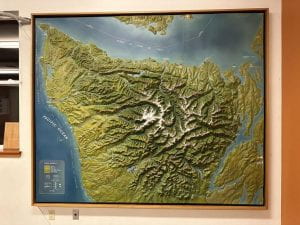
Figure 3. The map of glacier in Olympic Peninsula (shown in the white part)
However, a study published in the Journal of Glaciology pointed out that the glaciers are melting at a faster pace (Riedel et al., 2017). By comparing the Aerial photos taken in late 1970s and 2009, researchers found the surface of glaciers was reduced by 34% only in 30 years (Riedel et al., 2017). During the period from 1987 to 2009, the volume of ice was declined by at least 15% (Riedel et al., 2017).
The guide told us that if current pace continues, by 2050, the glacier will have completely melted away. By then, the summer rainforest will not have enough water to maintain its ecosystem, and the plants and animals that live in the rainforest will have a really hard time.
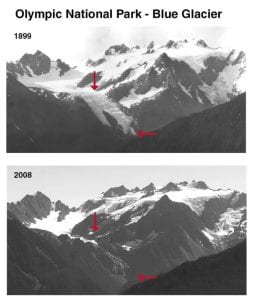
(a) Blue Glacier
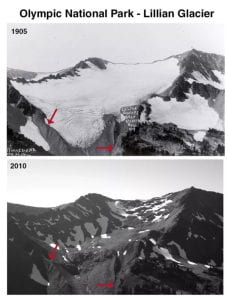
(b) Lillian Glacier
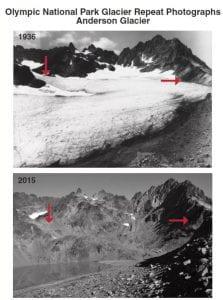
(c) Anderson Glacier
Figure 4. Comparison pictures of glacier changes from https://www.nps.gov/olym/learn/nature/glaciers.htm
Keyword 2: Salmon
Human activities indirectly impact temperate forest ecosystems through the medium of salmon.
First of all, anthropogenic disturbances significantly affect salmon living conditions in several ways. Here are the specific descriptions of each path.

Figure 5. Image taken in Quinnault National Fish Hatchery.
Riparian Vegetation Destructions. Fierce human disturbances to riparian vegetation (such as urban development and industrial activities) destabilize riverbanks and cause erosion. The resulting increase of sediment into salmon rivers scours incubating salmon. Sedimentation and vegetation loss decreases habitat stability and alters biological communities present in-river and along riverbanks.
Poor Water Quality. Water quality issues from pollutants can arise for salmon in areas affected by industrial and urban effluent input. These can have immediate lethal effects on salmon or even add a toxic-load to the salmon affecting physical condition and long-term general health. The Mount Polley mine disaster that spilled heavy metals into Polley Lake and Quesnel Lake is an example of this (Petticrew et al., 2015).
Migration Barriers. Many waterways are heavily modified, containing obstructions ranging from culverts to hydro-electric dams. These in-river barriers can limit salmon passage and reduce available habitat for salmon to spawn and rear. The Elwha Dams is an example. From 1911 to 2014, dams blocked fish passage on the lower Elwha River. Before the dams, 400,000 adult salmon returned yearly to spawn in 70 miles (110 km) of river habitat. Prior to dam removal, fewer than 4,000 salmon returned each year in only 4.9 miles (7.9 km) of habitat below the lower dam. The National Park Service removed the two dams as part of the Elwha Ecosystem Restoration Project, which began in September 2011 and was completed in August 2014.
Invasive Species Introductions. Invasive species compete with salmon for food and habitat. Many of these invasive species were historically introduced as sport fishes to create increased fishing opportunities by human-beings. The majority of these species are highly predatory and can be significant predators of juvenile salmon (e.g., Brown Trout (Alvarez & Ward, 2019)).

Figure 6. Image of fireweed, an example of invasive species.
Through altering the habitats of salmon, humans profoundly impact the quantity and quality of salmon and thus have a deeper effect on the temperate forest ecosystem.
Let’s take the Quinault Rain Forest Ranger Station as an example. Quinault Rain Forest, one of the 4 temperate rainforest canopies, is a riparian plant surrounding. It completely surrounds Lake Quinault, so the creatures like salmon in the river greatly impact its environment (Lake Quinault Washington, 2023).
Totally speaking, the salmon fertilize the temperate rainforest with open ocean nutrients stored in their bodies. The salmon are born in the freshwater but will swim back to the sea after 6 months to 3 years, and then go upstream to pawn after being an adult. After they spawn, both male and female ones will die. On the one hand, carnivores, such as bears, wolves and ravens, feed on the salmon carcasses and then the nutrition and energy flow along the food chain and finally enter the soil and fertilize the forest.
On the other hand, the left salmon is resolved by the resolver and the nutrition flows into the forest in a straight way. In addition, Salmon carcasses along riverbanks feed the insects that will nourish a new generation of fish the next spring. (Salmon build forests Raincoast Research) Hence, the salmon offers nutrition to the forest and then impacts the survival of other animals and the growth of plants. For example, in the 20th century, the decline in Pacific salmon population resulted in less food for fishers and a bad effect for reparation production (Hocking & Reynolds, 2011).
Keyword 3: Deforestation
The impact of deforestation on temperate rainforests is a thought-provoking issue, the continuous expansion of logging activities poses significant challenges to this unique natural environment.
Ecosystem destruction. One of the most immediate impacts of deforestation on temperate rainforests is ecosystem destruction. After forests are logged, many plants and animals lose their habitats. This can lead to a reduction in the number of species, some of which may even become endangered or extinct. The natural cycles of the forest can also be disrupted, affecting the ecological balance. In the areas surrounding Seattle, some affected animals include bears, deer, and various bird species.
Reduction in biodiversity. Deforestation can also lead to a reduction in biodiversity. Temperate rainforests are home to numerous endangered and endemic species, which have found unique adaptive environments within these forests. However, excessive logging can destroy these environments, making it difficult for these species to survive and reproduce.
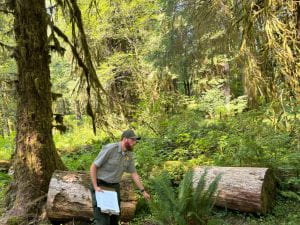
Figure 7. Images of fallen trees in Quinault Rainforest.
Climate change. Environmentalists also point out that deforestation exacerbates the issue of climate change. Temperate rainforests are crucial carbon sinks, converting a significant amount of carbon dioxide into oxygen through photosynthesis and storing carbon in trees and soil. However, logging results in the felling and burning of numerous trees, releasing stored carbon and contributing to higher concentrations of greenhouse gases in the atmosphere, thus intensifying global climate warming.
Sustainable forestry management. To address these issues, sustainable forestry management becomes crucial. Sustainable forestry management aims to strike a balance between timber demand and environmental conservation. This includes adopting appropriate logging methods, reforestation efforts, and protecting the habitats of endemic species. Some forestry companies in the Seattle area have already begun implementing these measures to minimize their environmental impact.
In conclusion, the impact of deforestation on temperate rainforests is a complex issue involving multiple aspects such as ecosystems, biodiversity, and climate change. We can observe the effects of human activities on the surrounding natural environment, underscoring the importance of sustainable forestry management to balance human activities and ecological preservation.
Keyword 4: Conclusion
The environment of the rainforests in Washington State is changing every day. At that time, humans, who live in part of the rainforest, are also changing. Not only the animals and plants that inhabit the rainforests, but also humans who live in close contact with them.
At this time, it is necessary for schools to provide students with opportunities to learn about the rainforests in Washington State and elsewhere. The term “Washington State rainforests” has a broad meaning. Therefore, focusing on issues such as the three above will make it easier for children to understand.
In addition, it is important to address today’s issues when educating about the rainforests. In this context, it is also important to learn about the relationship that we humans have had with the rainforests of Washington State in the past, and to think about how we should protect the rainforests of Washington State in the future.
We need to hand over the rainforest environment of the past to the future. By receiving lectures from experts, as shown in the photo, we can give back to the education of our children and to the rainforests of Washington State.
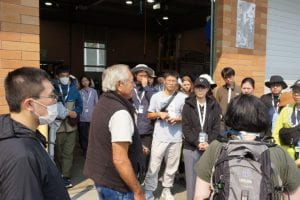
Figure 8. Photo of the lecture in Quinnault National Fish Hatchery.
References
Alvarez, J. S., & Ward, D. M. (2019). Predation on wild and hatchery salmon by non‐native brown trout (salmo trutta) in the Trinity River, California. Ecology of Freshwater Fish, 28(4), 573–585. https://doi.org/10.1111/eff.12476
Hocking, M. D., & Reynolds, J. D. (2011). Impacts of salmon on riparian plant diversity. Science, 331(6024), 1609–1612. https://doi.org/10.1126/science.1201079 Lake
Quinault Washington. (2023). Visit lake quinault, Washington. Lake Quinault Washington. https://quinaultrainforest.com/
National Parks Service. (2019, July 9). Glaciers and climate change. National Parks Service. https://www.nps.gov/olym/learn/nature/glaciers.htm
Petticrew, E. L., Albers, S. J., Baldwin, S. A., Carmack, E. C., Déry, S. J., Gantner, N., Graves, K. E., Laval, B., Morrison, J., Owens, P. N., Selbie, D. T., & Vagle, S. (2015). The impact of a catastrophic mine tailings impoundment spill into one of North America’s Largest Fjord Lakes: Quesnel Lake, British Columbia, Canada. Geophysical Research Letters, 42(9), 3347–3355. https://doi.org/10.1002/2015gl063345
Riedel, J. L., Wilson, S., Baccus, W., Larrabee, M., Fudge, T. J., & Fountain, A. (2017). Glacier status and contribution to streamflow in the Olympic Mountains, Washington, USA. Journal of Glaciology, 61(225), 8–16. https://doi.org/10.3189/2015jog14j138
